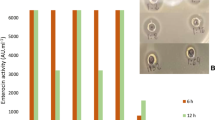Abstract
The enterotoxigenicity, klebocinogeny and auaceptibility to antibiotics for 100 strains ofKlebsiella pneumoniae isolated from various food samples is reported. 49% of the samples supported growth ofK. pneumoniae: a high proportion of these strains were isolated from sweets and snacks (51%). Enterotoxigenicity as determined by a coagglutination test with anti-LT coated staphylococci was observed in 61 of 100Klebsiella isolates. 21% of the strains were found to be kleboein producers against theK. pneumoniae WC indicator strain. A significant correlation was observed between Klebocinogeny and enterotoxigenicity (p < 0.05). Most strains (91 and 74% respectively) were inhibited by gentamicin and nalidixic acid. Most of the strains were multiply drug-resistant.
Similar content being viewed by others
References
Arora D.R., Chugh T.D.: Klebocin types ofKlebsiella pneumoniae isolated from normal and diarrhoeal stools.Ind. J. Med. Res. 73, 856–859 (1981).
Arora D.R., Chugh T.D., Vadehra D.V.: Enterotoxigenicity ofKlebsiella pneumoniae.Ind. J. Path. Microbiol. 26, 65–70 (1983).
Asnani P.J., Jhanjee A.:Klebsiella pneumoniae enterotoxin. II. Physico-chemical properties of enterotoxin.Acta Microbiol. Acad. Sci. Hung. 29, 139–145 (1982).
Bauer A.W., Kirby W.M.M., Sherris J.C., Turck M.: Antibiotic susceptibility testing by a standardized single sics method.Am. J. Clin. Path. 45, 493–497 (1966).
Caseweix M., Phillips I.: Food as a source ofKlebsiella species for colonization and infection of intesive care patients.J. Clin. Path. 31, 845–849 (1978).
Chhibber S., Vadehra D.V.: Purification and characterization of a bacteriocin fromKlebsiella pneumoniae 158.J. Gen. Microbiol. 132, 1051–1054 (1986).
Chugh T.D., Walia S., Sabharwal U.: Bacteriocin (klebocin) sensitivity typing as an epidemiological marker ofKlebsiella pneumoniae.Ind. J. Med. Res. 71, 195–202 (1980).
Deb M., Bhujwala R.A., Shriniwas A., Singh M.:Klebsiella pneumoniae as the possible cause of an outbreak of diarrhoaea in a noonatal special care unit.Ind. J. Med. Res. 71, 359–363 (1980).
Farmer J.J.: Mnemonic code for reporting bacteriocins and baeteriophago typing.Lancet II, 96 (1970).
Freij L.G., Sterkey G., Wadstrom T., Wall S.: Child health and diarrhoeal disease in relation to supply and use of water in African country.Progr. Water Technol. 11, 49–55 (1978).
Guerrant R.L., Moore R.A., Krischenfeld R.M., Sande M.A.: Role of toxigenic and invasige bacteria in acute diarrhoea of childhood.N. Engl. J. Med. 293, 567–573 (1975).
Klipstein F.A., Horowitz I.R., Engert R.F., Schnek E.A.: Effect ofKlebsiella pneumoniae on intestinal transport in the rat.J. Clin. Invest. 56, 799–807 (1975).
Klipstein F.A., Engert R.F.: Purification and properties ofKlebsiella pneumoniae heat stable enterotoxin.Infect. Immun. 13, 373–379 (1976).
Lee J.A., Kean B.H.: International conference of diarrhoea of traveller’s - new directions in research; a summary.J. Infect. Bis. 137, 355–369 (1978).
Lewis M.J.: Transferable drug resistance and other transferable agents in strains ofEscherichia coli from two human populations.Lancet I, 1389–1393 (1968).
Örskov I.: GenusKlebsiella pneumoniae, pp. 461–465 in N. R. Krieg, J. G. Holt (eds.):Bergey’s Manual of Systematic Bacteriology, 9th ed. Williams and Wilkins, Baltimore-London 1984.
Ronnberg B., Wadstrom T.: Rapid detection of heat labile enterotoxin in cell lysates from blood agar grownE. coli by a coagglutination test.J. Clin. Microbiol. 17, 1021–1025 (1983).
Sohoub B.D., Greff A.S., Lecatsas G., Prozesky O.W., Hay I.T., Prinsloo J.G., Ballard R.C.: A microbiological investigation of acute summer gastroenteritis in black South African infants.J. Hyg.(Cambridge) 78, 377–385 (1977).
Shooter R.A., Faiers M.C., Cooke E.M., Breaden A.L., O’Farrell S.M.: Isolation ofE. coli, P. aeruginosa andKlebsiella from food in hospital, canteens and schools.Lancet II, 390–392 (1971).
Stiles M.E., Ng L.:Enterobacteriaceae associated with meats and meat handling.Appl. Env. Microbiol. 41, 867–872 (1981).
Wadstrom T., Aust-Kettis A., Habte D., Holmgren J., Meeuwisse G., Mollba R., Suderlind O.: Enterotoxin producing bacteria and parasites in stools of Ethiopian children.Arch. Dis. Child. 51, 865–870 (1976).
Author information
Authors and Affiliations
Rights and permissions
About this article
Cite this article
Kaura, J., Kaul, M. & Chhibbbr, S. Enterotoxigenicity, klebocinogeny and antibiotic resistance pattern of food isolates ofKlebsiella pneumoniae . Folia Microbiol 33, 500–506 (1988). https://doi.org/10.1007/BF02925777
Received:
Revised:
Issue Date:
DOI: https://doi.org/10.1007/BF02925777




